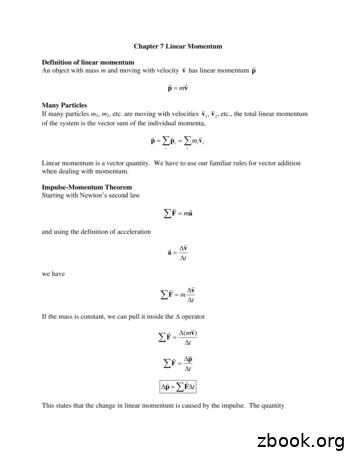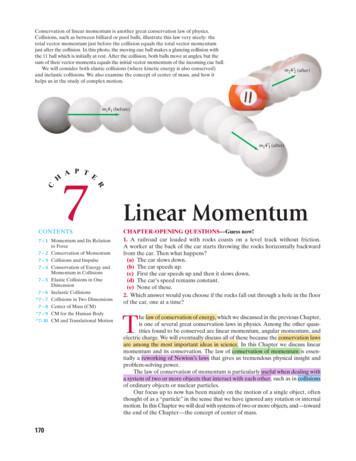Linear Momentum - University Of Massachusetts Lowell
Lecture 15Chapter 9Physics I10.30.2013Linear MomentumCourse website:http://faculty.uml.edu/Andriy Danylov/Teaching/PhysicsILecture 1fall.html95.141, Fall 2013, Lecture 15Department of Physics and Applied Physics
OutlineChapter 9 MomentumConservation of momentumImpulseCollisions (Elastic & Inelastic)95.141, Fall 2013, Lecture 15Department of Physics and Applied Physics
Exam II InfoExam II Mon Nov 4, 9:00-9:50am, OH 150.Exam II covers Chapters 5-8Same format as Exam IPrior Examples of Exam II postedCh. 5: Using Newton’s Laws, Friction, Uniform Circular motionCh. 6: Universal Law of Gravitation, Kepler’s LawsCh. 7: Work & EnergyCh. 8: Conservation of EnergyExam Review Session Thursday 6-8pm, Ball 21095.141, Fall 2013, Lecture 15Department of Physics and Applied Physics
Linear Momentum vmLinear momentum is defined as the product of an object’smass and velocity: p mvMomentum is a VECTOR !Units of momentum: kg msThe greater the linear momentum of a body , the greater itstendency to continue in motion.An iron shot (m larger) is harder to stop than a baseball (m small) of the same velocity.95.141, Fall 2013, Lecture 15Department of Physics and Applied Physics
Force and Momentum (Newton’s 2nd law)Let’s rewrite Newton’s 2nd law in terms of momentum: dv d dp F ma m dt dt (mv) dt dp F dtThe rate of change of momentum is equal to the net forceSo, a force is required to change momentum of an object.95.141, Fall 2013, Lecture 15Department of Physics and Applied Physics
How to find an average force?This can be used to get average force from momentum change: pi mvi Fnet t p f mv fSo, let’s rewrite N. 2nd law for anaverage force: dp F dt p p f piFaverage t tLet’s look at an example:95.141, Fall 2013, Lecture 15Department of Physics and Applied Physics
Example: finding an average forceThe speed of a fastball is about 40 m/s, and the speed of the ball coming off ofplayer’s bat for a home run is about 54 m/s. The ball (0.145kg) is in contactwith the bat for 1ms. What is the average Force exerted by the player?xFaverage p f pi t m(v f ( vi )) tPay attention to directions!!!!!!!!Faverage(0.145kg )[54 40]m / s 0.001sFaverage 136,300 N95.141, Fall 2013, Lecture 15Department of Physics and Applied Physics in the direction of v f or x
ConcepTest 1 Two Boxes/MomentumTwo boxes, one heavier than theother, are initially at rest on ahorizontal frictionless surface.The same constant force F actson each one for exactly 1 second.Which box has more momentumafter the force acts ? p p f piF We know: av t tA) the heavier oneB) the lighter oneC) both the samepi 0p f Fav tIn this case F and t are thesame for both boxes!Both boxes will have thesame final momentum.FlightFheavy
ConcepTest 2 Two Boxes/velocityIn the previous question,A) the heavier onewhich box has the largerB) the lighter onevelocity after the force acts?C) both the sameMvh p f mvlSince M m, then vl vh
Conservation of MomentumFrom Newton’s 2nd law: dp F dt dpIf Fexternal 0 , then 0 , thus p constdtIf no net external force acts on a system, itsmomentum is conserved. mA v A mB vB mAvA mB vB ' ' Pfinal mA vA mB vBPinitial mA vA mB vB ' 'Pinitial Pfinalm A v A mB v B m A v A mB v B95.141, Fall 2013, Lecture 15Department of Physics and Applied Physics
Why is Momentum conserved? FN1 FN 2 m1 g m2 gmgs are canceled by normal forces,so net external force is zero,and the momentum is conserved m1 g FN 2 m2 gThe net external force is m1g,and the momentum is NOT conservedIsolated system is a system on which no external forces act.There are only internal forces acting between objects.this system (two balls) is isolatedthis system (two balls) is NOT isolatedThe total momentum of an isolated system of objectsis conserved95.141, Fall 2013, Lecture 15Department of Physics and Applied Physics
Internal forces of an isolated systemInternal forces of an isolated system.A acts on B:B acts on A: FBA FABForces equal and opposite (Newton’s 3rd Law). FAB FBAThus, they all cancel each other. That’s whythey cannot ruin conservation of momentum.(It is not a proof)95.141, Fall 2013, Lecture 15Department of Physics and Applied Physics FAB FBADuring collision
ImpulseDuring a collision, objects are deformed because of thelarge forces involved .How to relate those forces with a changein momentum? dpFrom Newton’s 2nd law: F dtIntegrate it: tfti F dt pfpi Fdt dp dp p f pi p piJ pfAfter collisionBefore collisiontfForce exerted onone of the balls Define Impulse as: Fdt JtiSo, Impulse area under F-vs-t curve Impulse change in momentumJ p95.141, Fall 2013, Lecture 15Department of Physics and Applied Physics
Impulse/Average forceThe exact variation of F with time is very often notknown. So, it is easier to find an average force.JJthe same Jtf Favg t Fdt ptiHow to avoid broken legs Favg t pHaving a certain p, a cat by bending its lags tries to increase t(impact time), so that an impact force would be reduced.(intuitive knowledge of Physics )95.141, Fall 2013, Lecture 15Department of Physics and Applied Physics
Example: Tennis ball/impulseThe force exerted by a tennis racket on the ball (mass 56 g)during a serve ( vi 0 )can be approximated by the F vs timeplot below.What is the impulse on the ball?tf What is the speed of the serve? 0 Fdt J p f pi0ti2Area under force-time curve is an impulse:Force (kN)2kN 2msJ Area 2 () 4N s2Jvf J p f mv fmTime (ms)1095.141, Fall 2013, Lecture 15Department of Physics and Applied Physics4 N svf 71 m/s0.056 kg
Different types of collisionsMomentum is conserved in any two-body collision(since there is no net external force)Is mechanical energy conserved in these collisions?Metal balls get deformed and restoredMech. energy is conservedElastic collision95.141, Fall 2013, Lecture 15Department of Physics and Applied PhysicsCars get deformed and not restored.Some Mech. Energy is spent on deformation.Mech. energy is NOT conservedInelastic collision
1-D Elastic Collisions95.141, Fall 2013, Lecture 15Department of Physics and Applied Physics
Elastic Collision Math (1D) mA v A mAvA mB vB mB vB Conservation of momentummA vA mB vB mA v A mB v BConservation of mech. energy22221111 mv mv m mvvA AB BA AB B2222mA vA mA v A mB v B mB vBmA v 2A mA v A2 mB v B2 mB vB2mA (vA v A ) mB (v B vB )mA (v 2A v A2 ) mB (v B2 vB2 )mA (vA v A )(vA v A ) mB (v B vB )(v B vB )vA v A v B vBv A vB (v A v B )Relative velocities switch signs in the collision95.141, Fall 2013, Lecture 15Department of Physics and Applied Physics
Elastic Collision Math (1D)1stmA vA mB vB mA v A mB v B122ndConservation of momentummA v 2A 12 mB vB2 12 mA v A2 12 mB v B2 Conservation of mechanical energymA vA mB vB mA v A mB v B Conservation of momentumv A vB (v A v B )Conservation of mechanical energySo, instead of the 1st set of “crazy” equations,we can use the 2nd one which is easier (both are linear)95.141, Fall 2013, Lecture 15Department of Physics and Applied Physics
Example: Ballistic PendulumA device used to measure the speed of a bullet.m voMM m95.141, Fall 2013, Lecture 15Department of Physics and Applied Physicshv1
Example: Ballistic Pendulum (cont.)ForBullet mass 10 gBlock mass is 3 kgBlock swings up to a height of 5 cmthe speed of a bullet95.141, Fall 2013, Lecture 15Department of Physics and Applied Physicsv o 298 m s
A Different Ballistic “Pendulum”A device used to measure the speed of a bullet.Bullet mass 30 gBlock mass is 5 kgSpring compresses by 12 cmSpring constant k 300 N/mBullet velocity before collision?mMM mv0 v1m11 22(M m)v1 kx22kv1 xM mvo 155.4 m sv1 0.93 m smv0 (M m)v195.141, Fall 2013, Lecture 15Department of Physics and Applied Physics
Thank youSee you on Monday95.141, Fall 2013, Lecture 15Department of Physics and Applied Physics
Linear Momentum Linear momentum is defined as the product of an object's mass and velocity: p mv Units of momentum:s kg m The greater the linear momentum of a body , the greater its tendency to continue in motion. v m An iron shot (m larger) is harder to stop than a baseball (m small) of the same velocity. Momentum is a VECTOR !
1. Impulse and Momentum: You should understand impulse and linear momentum so you can: a. Relate mass, velocity, and linear momentum for a moving body, and calculate the total linear momentum of a system of bodies. Just use the good old momentum equation. b. Relate impulse to the change in linear momentum and the average force acting on a body.
momentum is kg·m/s. Linear Momentum Linear momentum is defined as the product of a system's mass multiplied by its velocity: p mv. (8.2) Example 8.1Calculating Momentum: A Football Player and a Football (a) Calculate the momentum of a 110-kg football player running at 8.00 m/s. (b) Compare the player's momentum with the
CHAPTER 3 MOMENTUM AND IMPULSE prepared by Yew Sze Ling@Fiona, KML 2 3.1 Momentum and Impulse Momentum The linear momentum (or "momentum" for short) of an object is defined as the product of its mass and its velocity. p mv & & SI unit of momentum: kgms-1 or Ns Momentum is vector quantity that has the same direction as the velocity.
Linear momentum is always conserved for an isolated system. Of course, we deal with components ix fx iy fy p p and p p I like to say that momentum is conserved in collisions and explosions. Note: The total momentum of the system is conserved. The momentum of an individual particle can change. Problem 18.
4. Impulse - Momentum 3. This area is called Impulse F.dt r. 5/14/2008 Momentum - 1 25 Force, Time and Momentum The area under the force-time graph equals the change in linear momentum. If the LHS of this . Collisions - Linear Momentum is always conserved Is the collision force gravity or springs? - If YES, then Kinetic .
p Linear momentum of a particle of mass and velocity The Linear Momentum SI unit for li is defined as neal momentum: is the kg.m/s pmv p mv pmv The time rate of change of the linear momentum of a particle is equal to the magnitude of net force acting on th Below we will prove the fol e particle and has the direc lowing statem tion of the f ent .
The linear momentum (or "momentum" for short) of an object is defined as the product of its mass and its velocity. Momentum (plural is momenta—from Latin) is represented by the symbol If we let m represent the mass of an object and represent its velocity, then its momentum is defined as (7;1) Velocity is a vector, so momentum too is a vector.
Keyboards Together 2 Music Medals Bronze Ensemble Pieces (ABRSM) B (T) In the Meadow Stood a Little Birch Tree Trad. Russian, arr. Mike Cornick: p. 3 B (T) Jazz Carousel Jane Sebba: p. 4 B (T) Heading for Home John Caudwell: p. 5 B (T) Don’t Mess with Me! Peter Gritton: p. 6























